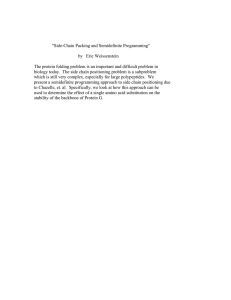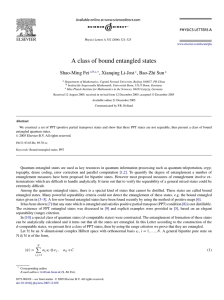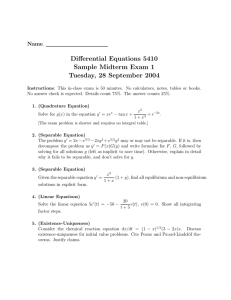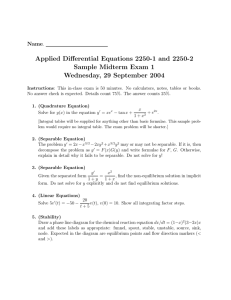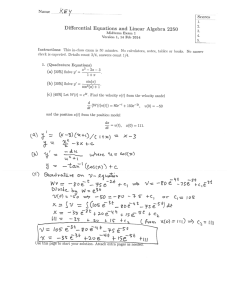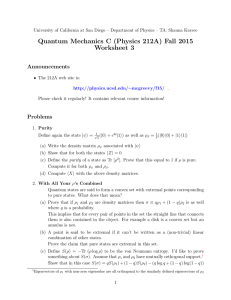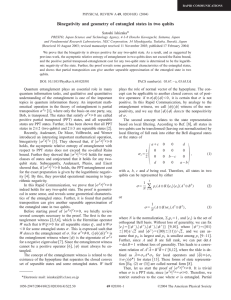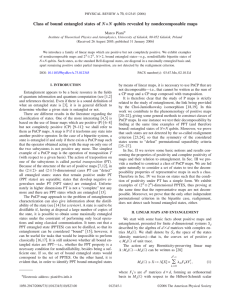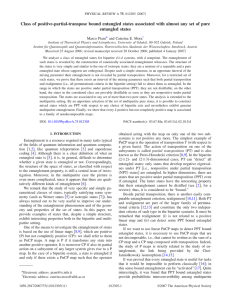Distinguishing Separable and Entangled States
advertisement
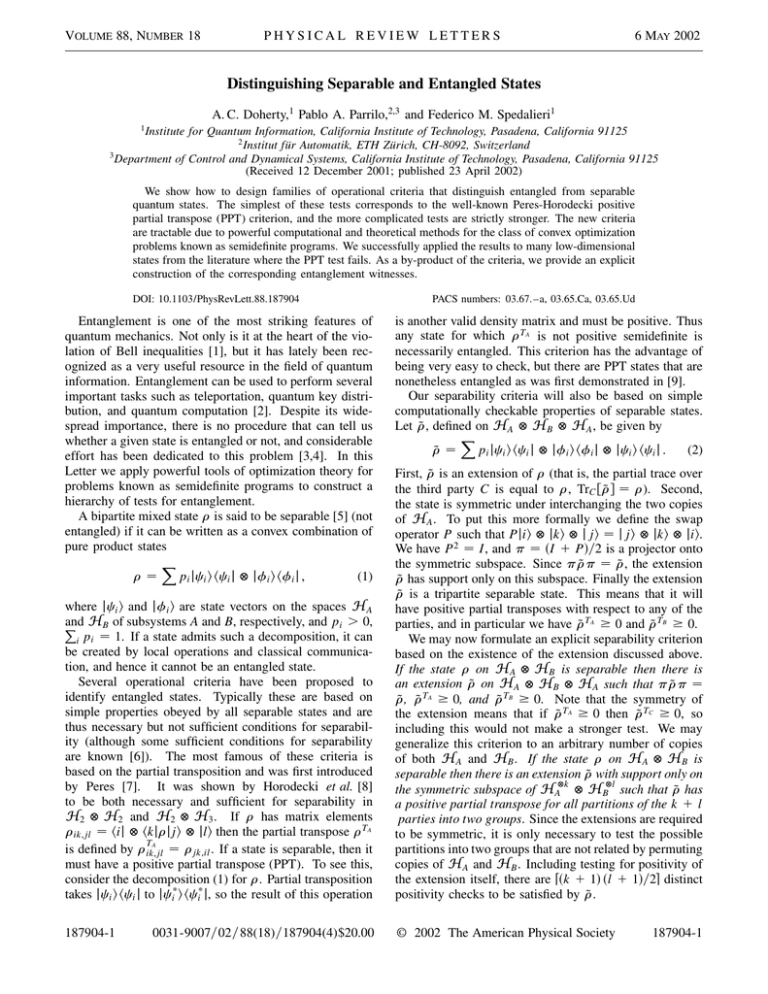
VOLUME 88, NUMBER 18 PHYSICAL REVIEW LETTERS 6 MAY 2002 Distinguishing Separable and Entangled States A. C. Doherty,1 Pablo A. Parrilo,2,3 and Federico M. Spedalieri1 1 Institute for Quantum Information, California Institute of Technology, Pasadena, California 91125 2 Institut für Automatik, ETH Zürich, CH-8092, Switzerland 3 Department of Control and Dynamical Systems, California Institute of Technology, Pasadena, California 91125 (Received 12 December 2001; published 23 April 2002) We show how to design families of operational criteria that distinguish entangled from separable quantum states. The simplest of these tests corresponds to the well-known Peres-Horodecki positive partial transpose (PPT) criterion, and the more complicated tests are strictly stronger. The new criteria are tractable due to powerful computational and theoretical methods for the class of convex optimization problems known as semidefinite programs. We successfully applied the results to many low-dimensional states from the literature where the PPT test fails. As a by-product of the criteria, we provide an explicit construction of the corresponding entanglement witnesses. DOI: 10.1103/PhysRevLett.88.187904 Entanglement is one of the most striking features of quantum mechanics. Not only is it at the heart of the violation of Bell inequalities [1], but it has lately been recognized as a very useful resource in the field of quantum information. Entanglement can be used to perform several important tasks such as teleportation, quantum key distribution, and quantum computation [2]. Despite its widespread importance, there is no procedure that can tell us whether a given state is entangled or not, and considerable effort has been dedicated to this problem [3,4]. In this Letter we apply powerful tools of optimization theory for problems known as semidefinite programs to construct a hierarchy of tests for entanglement. A bipartite mixed state r is said to be separable [5] (not entangled) if it can be written as a convex combination of pure product states X (1) r苷 pi jci 典 具ci j ≠ jfi 典 具fi j , PACS numbers: 03.67. –a, 03.65.Ca, 03.65.Ud is another valid density matrix and must be positive. Thus any state for which r TA is not positive semidefinite is necessarily entangled. This criterion has the advantage of being very easy to check, but there are PPT states that are nonetheless entangled as was first demonstrated in [9]. Our separability criteria will also be based on simple computationally checkable properties of separable states. Let r̃, defined on HA ≠ HB ≠ HA , be given by X r̃ 苷 pi jci 典 具ci j ≠ jfi 典 具fi j ≠ jci 典 具ci j . (2) where jci 典 and jfi 典 are state vectors on the spaces HA and P HB of subsystems A and B, respectively, and pi . 0, i pi 苷 1. If a state admits such a decomposition, it can be created by local operations and classical communication, and hence it cannot be an entangled state. Several operational criteria have been proposed to identify entangled states. Typically these are based on simple properties obeyed by all separable states and are thus necessary but not sufficient conditions for separability (although some sufficient conditions for separability are known [6]). The most famous of these criteria is based on the partial transposition and was first introduced by Peres [7]. It was shown by Horodecki et al. [8] to be both necessary and sufficient for separability in H2 ≠ H2 and H2 ≠ H3 . If r has matrix elements rik,jl 苷 具ij ≠ 具kjrjj典 ≠ jl典 then the partial transpose r TA TA is defined by rik,jl 苷 rjk,il . If a state is separable, then it must have a positive partial transpose (PPT). To see this, consider the decomposition (1) for r. Partial transposition takes jci 典 具ci j to jciⴱ 典 具ciⴱ j, so the result of this operation First, r̃ is an extension of r (that is, the partial trace over the third party C is equal to r, TrC 关r̃兴 苷 r). Second, the state is symmetric under interchanging the two copies of HA . To put this more formally we define the swap operator P such that Pji典 ≠ jk典 ≠ j j典 苷 j j典 ≠ jk典 ≠ ji典. We have P 2 苷 I, and p 苷 共I 1 P兲兾2 is a projector onto the symmetric subspace. Since p r̃p 苷 r̃, the extension r̃ has support only on this subspace. Finally the extension r̃ is a tripartite separable state. This means that it will have positive partial transposes with respect to any of the parties, and in particular we have r̃ TA $ 0 and r̃ TB $ 0. We may now formulate an explicit separability criterion based on the existence of the extension discussed above. If the state r on HA ≠ HB is separable then there is an extension r̃ on HA ≠ HB ≠ HA such that p r̃p 苷 r̃, r̃ TA $ 0, and r̃ TB $ 0. Note that the symmetry of the extension means that if r̃ TA $ 0 then r̃ TC $ 0, so including this would not make a stronger test. We may generalize this criterion to an arbitrary number of copies of both HA and HB . If the state r on HA ≠ HB is separable then there is an extension r̃ with support only on the symmetric subspace of HA≠k ≠ HB≠l such that r̃ has a positive partial transpose for all partitions of the k 1 l parties into two groups. Since the extensions are required to be symmetric, it is only necessary to test the possible partitions into two groups that are not related by permuting copies of HA and HB . Including testing for positivity of the extension itself, there are d共k 1 1兲 共l 1 1兲兾2e distinct positivity checks to be satisfied by r̃. 187904-1 © 2002 The American Physical Society 0031-9007兾02兾 88(18)兾187904(4)$20.00 187904-1 VOLUME 88, NUMBER 18 These results generate a hierarchy of necessary conditions for separability. The first is the usual PPT test for a bipartite density matrix r. If the test fails, the state is entangled; if the test is passed, the state could be separable or entangled. In the latter case we look for an extension r̃ of r to three parties such that p r̃p 苷 r̃ satisfies the PPT test for all possible partial transposes. If no such extension exists, then r must be entangled. If such an extension is possible, the state could be separable or entangled, and we need to consider an extension to four parties, and so on. Each test in this sequence is at least as powerful as the previous one. We can see this by showing that, if there is a PPT extension r̃n to n parties, then there must be a PPT extension r̃n21 to n 2 1 parties. Let r̃n21 苷 TrX 关r̃n 兴, X being one of the copies of A or B. Then r̃n21 will inherit from r̃n the property of having its support on the symmetric subspace. Let’s assume that it is not PPT. TI Then there is a subset I of the parties such that r̃n21 has a negative eigenvalue, where TI represents the partial transpose with respect to all the parties in subset I . Let je典 be the corresponding eigenvector and let 兵ji典其 be a basis of the system X over which the partial trace was performed. Since r̃n is PPT, then 具ej 具ijr̃nTI je典 ji典 $ 0, for all i. Then X 具ej 具ijr̃nTI je典 ji典 苷 具ej TrX 关r̃nTI 兴 je典 $ 0 . (3) i Since X ” I , we can commute the trace and the partial transpose, and, using r̃n21 苷 TrX 关r̃n 兴, we have TI 具ejr̃n21 je典 $ 0, which contradicts the fact that je典 is an TI eigenvector of r̃n21 with negative eigenvalue. The problem of searching for the extension can be solved efficiently, since it can be stated as a particular case of the class of convex optimizations known as semidefinite programs (SDP) [10]. A SDP corresponds to the optimization of a linear function, subject to a linear matrix inequality (LMI). A typical SDP will be minimize cT x , (4) subject to F共x兲 $ 0 , where P c is a given vector, x 苷 共x1 , . . . , xm 兲, and F共x兲 苷 F0 1 i xi Fi , for some fixed n-by-n Hermitian matrices F0 苷 6 MAY 2002 PHYSICAL REVIEW LETTERS X r1j s1A ≠ sjB ≠ s1A 1 j Fiji 苷 siA ≠ sjB ≠ siA , X Fj . The inequality in the second line of (4) means that the matrix F共x兲 is positive semidefinite. The vector x is the variable over which the minimization is performed. In the particular instance in which c 苷 0, there is no function to minimize and the problem reduces to whether or not it is possible to find x such that F共x兲 is positive semidefinite. This is termed a feasibility problem. The convexity of SDPs has made it possible to develop sophisticated and reliable analytical and numerical methods for them [10]. The separability criteria we introduced above may all be formulated as semidefinite programs. For brevity we will explicitly consider only the problem of searching for an extension of r to three parties. We will also relax the symmetry requirements on the extension r̃, and we will ask only P r̃P 苷 r̃. This increases the size of the SDP, but simplifies the setup. Let 兵siA 其i苷1,...,dA2 and 兵sjB 其j苷1,...,dB2 be bases for the space of Hermitian matrices that operate on HA and HB , respectively, such that they satisfy Tr共siX sjX 兲 苷 adij and Tr共siX 兲 苷 di1 , (5) where X stands for A or B, and a is some constant — the generators of SU共n兲 could be used to form such a basis. We canPthen expand r in the basis 兵siA ≠ sjB 其, and write r 苷 ij rij siA ≠ sjB , with rij 苷 a 22 Tr关rsiA ≠ sjB 兴. We can write the extension r̃ in a similar way r̃ 苷 X ij i,k 1 r̃kji 兵siA ≠ sjB ≠ skA 1 skA ≠ sjB ≠ siA 其 X r̃kjk skA ≠ sjB ≠ skA , (6) kj where we have explicitly used the symmetry between the first and third party. We also need to satisfy TrC 共r̃兲 苷 r. Using (5), and the fact that the siA ≠ sjB form a basis of the space of Hermitian matrices on HA ≠ HB , we obtain r̃ij1 苷 rij . The remaining components of r̃ will be the variables in our SDP. The LMIs come from requiring that the state r̃ and its partial transposes be positive semidefinite. For example, P the condition r̃ $ 0 will take the form F共x兲 苷 F0 1 i xi Fi $ 0 if we define rij 兵siA ≠ sjB ≠ s1A 1 s1A ≠ sjB ≠ siA 其 , i苷2,j苷1 i $ 2, Fijk 苷 共siA ≠ sjB ≠ skA 1 skA ≠ sjB ≠ siA 兲, k . i $ 2. The coefficients r̃ijk 共k fi 1, k $ i兲 play the role of the variable x. There are m 苷 共dA4 dB2 2 dA2 dB2 兲兾2 components of x, where dI is the dimension of HI . Each F is a square matrix of dimension n 苷 dA2 dB . Positivity of the partial transposes TA and TB leads to two more LMIs, r̃ TA $ 0 and r̃ TB $ 0. The F matrices for these two LMIs are related to the matrices Fijk by the appropriate partial transposition. We can write these three LMIs as one, if we define the T T matrix G 苷 r̃ © r̃ TA © r̃ TB , so for example, G0 苷 F0 © F0 A © F0 B (a block-diagonal matrix C 苷 A © B is positive semidefinite if, and only if, both A and B are positive semidefinite). So the feasibility problem reduces to attempting to find r̃ijk 共k fi 1, k $ i兲 with G $ 0. In fact, the SDP corresponding to minimizing t subject to tIABA 1 G $ 0 is always feasible and performs better numerically. A positive optimum gives a value of p ⴱ such that 共1 2 p兲r 1 pIAB 兾dA dB is entangled for all 0 # p , p ⴱ . Looking for an extension on HA≠k ≠ HB≠l is a semidefinite program 187904-2 187904-2 VOLUME 88, NUMBER 18 with m 苷 共 dA 1k21 兲2 共 dB 1l21 兲2 2 dA2 dB2 variables and a k l matrix G with d共k 1 1兲 共l 1 1兲兾2e blocks of dimension at 兲2 共 dB 1dl兾2e21 most 共 dA 1dk兾2e21 兲2 . dl兾2e dk兾2e Numerical SDP solvers are described in detail in [10]. Typically they involve the solution of a series of least squares problems, each requiring a number of operations scaling with a problem size as O共m2 n2 兲. For SDPs with a block structure these break into independent parts, each with a value of n determined by the block size. The number of iterations required is known to scale no worse than O共n1兾2 兲. Thus for any fixed value of 共k, l兲 the computation involved in checking our criteria scales no worse than 13k兾2 13l兾2 O共dA dB 兲 which is polynomial in the system size. Using the SDP solver SeDuMi [11], we applied the first criterion 共k 苷 2, l 苷 1兲 to several examples of PPT entangled states with dA 苷 2, dB 苷 4 or dA 苷 3, dB 苷 3. On a 500 MHz desktop computer a single state could be tested in under a second for dA 苷 2, dB 苷 4 and in about eight seconds for dA 苷 3, dB 苷 3. For the one and two parameter families of PPT entangled states described in [3,9,12] we performed a systematic search of the parameter space, in each case testing hundreds or thousands of different states. We checked 4000 randomly chosen examples of the seven parameter family of PPT entangled states in [13]. We also checked the PPT entangled states constructed from unextendable product bases in [14]. We did not find any PPT entangled state with an extension of the required form, thus verifying the entanglement of all these states. Very close to the separable states the test was inconclusive due to numerical uncertainties. Uncertainties and one example are discussed more fully below. A very useful property of a SDP is the existence of the dual problem. If a problem can be stated as a SDP like (4), usually called the primal problem, then the dual problem corresponds to another SDP that can be written as maximize 2 Tr关F0 Z兴 subject to Z$0 (7) Tr关Fi Z兴 苷 ci , where the matrix Z is Hermitian and is the variable over which the maximization is performed. For any feasible solutions of the primal and dual problems we have c x 1 Tr关F0 Z兴 苷 Tr关F共x兲Z兴 $ 0 , T Tr关rsep W 兴 $ 0 and Tr关rW兴 , 0 , where rsep is any separable state. If our primal SDP is infeasible (which means that the state r must be entangled), the dual problem provides a certificate of that infeasibility that can be used to construct an EW for r. First, we note that, due to the block diagonal structure of the LMI, we can restrict any feasible dual solution Z to T T have the same structure, i.e., Z 苷 Z0 © Z1 A © Z2 B where the Zi are operators on HA ≠ HB ≠ HA . Second, we have Tr关G0 Z兴 苷 Tr关F0 共Z0 1 Z1 1 Z2 兲兴. We defined F0 as a linear function of r so that F0 苷 L共r兲, where L is a linear map from HA ≠ HB to HA ≠ HB ≠ HA . We can now define an operator Z̃ on HA ≠ HB through the adjoint map Lⴱ such that Z̃ 苷 Lⴱ 共Z0 1 Z1 1 Z2 兲 and Tr关r Z̃兴 苷 Tr关L共r兲 共Z0 1 Z1 1 Z2 兲兴 苷 Tr关G0 Z兴 . (10) If rsep is any separable state, we know that the primal problem is feasible (the extension r̃ exists). Then, using Tr关G0 Z兴 $ 0 and (10), we have Tr关rsep Z̃兴 $ 0 for any Z̃ obtained from a dual feasible solution. For this particular problem, if the primal is not feasible (which means r is an entangled state), a feasible dual solution ZEW that satisfies Tr关G0 ZEW 兴 , 0 always exists. Using (10) we can see that the corresponding operator Z̃EW satisfies Tr关r Z̃EW 兴 , 0 which together with Tr关rsep Z̃EW 兴 $ 0 means that Z̃EW is an entanglement witness for r. In numerical work, if the SDP solver cannot find an extension r̃ it constructs the matrices Zi . Evaluating Tr关rZ̃EW 兴 and verifying the three positivity conditions provide an independent check of the result. Unless this check is not conclusive — for example, if Tr关r Z̃EW 兴 is not significantly different from zero — we are able to definitively conclude that no r̃ exists. If W is an EW, then for any product state jxy典 we have X E共x, y兲 苷 具xyjWjxy典 苷 Wijkl xiⴱ yjⴱ xk yl $ 0 , (11) ijkl where 兵xi , yi 其 are the components of jx典, j y典 in some basis, and Wijkl are the matrix elements of W in the same basis. Equation (11) states that the biquadratic Hermitian form E associated with W must be positive semidefinite (PSD). It is not hard to show that all of the EWs generated by Eq. (10) satisfy the relation 具xyxjZ̃EW ≠ Ijxyx典 苷 具xyxj 共Z0 1 Z1 1 Z2 兲 jxyx典 苷 具xyxjZ0 jxyx典 1 具x ⴱ yxjZ1 A jx ⴱ yx典 T (8) where the last inequality follows from the fact that both F共x兲 and Z are positive semidefinite. Then, for the particular case of a feasibility problem 共c 苷 0兲, Eq. (8) will read Tr关F0 Z兴 $ 0. This result can be used to give a certificate of infeasibility for the primal problem: if there exists Z such that Z $ 0, Tr关Fi Z兴 苷 0, that satisfies Tr关F0 Z兴 , 0, then the primal problem must be infeasible. In the context of entanglement, the role of the “certificate” is played by observables known as entanglement witnesses (EW) [8,15]. An EW for a state r satisfies 187904-3 6 MAY 2002 PHYSICAL REVIEW LETTERS (9) 1 具xy ⴱ xjZ2 B jxy ⴱ x典 . T T Z1 A , (12) T Z2 B Since Z0 , and are positive by construction the biquadratic Hermitian form E共x, y兲 具x j x典 has a decomposition as a sum of squared (SOS) magnitudes. This guarantees that E共x, y兲 is PSD. It can be shown that our first separability criterion detects all entangled states that possess an EW such that E may be written in this form. The dual program to our initial SDP may be interpreted as a search for an entanglement witness of this type. Equally, the Peres-Horodecki criterion detects the entanglement of those states which possess entanglement witnesses 187904-3 VOLUME 88, NUMBER 18 for which (11) may be written directly as a SOS — the decomposable entanglement witnesses [16] such that W 苷 P 1 Q TA for some PSD P and Q. In general, if there is no EW W such that (11) is a SOS, we can search over W for which (11) is a SOS when multiplied by 具x j x典k21 具 y j y典l21 for some k, l $ 1. By duality, this corresponds to our 共k, l兲 separability criterion. As an example illustrating the methodology, consider the state described in [3], Section 4.6, given by ra 苷 6 MAY 2002 PHYSICAL REVIEW LETTERS 2 a 52a jc1 典 具c1 j 1 s1 1 Ps1 P , (13) 7 7 7 with 0 # a # 5, 1 3 共j01典 具01j jc1 典 苷 p1 3 P2 i苷0 jii典, and s1 苷 1 j12典 具12j 1 j20典 具20j兲. Notice that ra is invariant under the simultaneous change of a ! 5 2 a and interchange of the parties. The state is separable for 2 # a # 3 and not PPT for a . 4 and a , 1. Numerically, entanglement witnesses could be constructed for ra in the range 3 1 e , a # 4 (and 1 # a , 2 2 e) with e $ 1028 . A witness for a . 3 can be extracted from these by inspection Z̃EW 苷 2共j00典 具00j 1 j11典 具11j 1 j22典 具22j兲 1 j02典 3 具02j 1 j10典 具10j 1 j21典 具21j 2 3jc1 典 具c1 j . This observable is non-negative on separable states: 2具xyjZ̃EW jxy典 具x j x典 苷 j2x0 x1 y2ⴱ 2 x2 x0 y1ⴱ 2 x1 x2 y0ⴱ j2 1 j2x0 x0ⴱ y0 2 2x1 x0ⴱ y1 1 x1 x1ⴱ y0 2 x2 x0ⴱ y2 j2 1 j2x0 x0ⴱ y2 2 2x1 x2ⴱy1 1 x2 x2ⴱ y2 2 x0 x2ⴱ y0 j2 1 j2x0 x1ⴱ y0 2 2x2 x2ⴱ y1 1 x2 x1ⴱ y2 2 x1 x1ⴱ y1 j2 1 3jx2 x0 y1ⴱ 2 x1 x2 y0ⴱ j2 1 3jx1 x1ⴱ y0 2 x2 x0ⴱ y2 j2 1 3jx2 x2ⴱ y2 2 x0 x2ⴱ y0 j2 1 3jx2 x1ⴱ y2 2 x1 x1ⴱ y1 j2 $ 0. The expected value on the original state is Tr关Z̃EW ra 兴 苷 1 7 共3 2 a兲, demonstrating entanglement for all a . 3. The reformulation of our separability tests as a search for SOS decompositions of the forms E共x, y兲 provides connections with existing results in real algebra (see [17] for a discussion of the SDP-based approach in a general setting). By Artin’s positive solution to Hilbert’s 17th problem, for any real PSD form f共x兲 there exists a SOS form h共x兲, such that the product f共x兲h共x兲 is SOS [18]. Finding such an h共x兲 and SOS decomposition proves that f is PSD. For a fixed SOS form h共x, y兲, we may write a SDP that attempts to find EWs such that h共x, y兲E共x, y兲 is SOS. In our hierarchy of criteria the form h is restricted to be 具x j x典k21 具 y j y典l21. While it is conceivable that every PSD bi-Hermitian form is SOS when multiplied by appropriate factors of this type, currently we do not have a proof. Deciding whether a form is positive is computationally hard and so this connection to positive forms also promises to shed light on the computational complexity of the separability problem. In this Letter we introduced a hierarchy of separability tests that are computationally tractable and strictly stronger than the PPT criterion. Only the second step in this sequence of tests was required to detect the entanglement of a wide class of known PPT entangled states. The method is based on the application of semidefinite programs. By exploiting the duality property of these problems, we showed how to construct entanglement witnesses for states that fail any separability test in the sequence. Finally, the wide range of applications of semidefinite programming, along with the work reported here and in [19], suggests that it may become a useful tool in quantum information and in quantum theory in general. It is a pleasure to acknowledge conversations with Hideo Mabuchi, John Doyle, John Preskill, and Patrick Hayden. 187904-4 This work was supported by the Caltech MURI Center for Quantum Networks, the NSF Institute for Quantum Information, and the Caltech MURI Center for Uncertainty Management for Complex Systems. [1] J. S. Bell, Physics (Long Island City, N.Y.) 1, 195 (1964). [2] M. N. Nielsen and I. L. Chuang, Quantum Computation and Quantum Information (Cambridge University Press, Cambridge, 2000). [3] M. Horodecki, P. Horodecki, and R. Horodecki, quantph/0109124. [4] M. Lewenstein et al., J. Mod. Opt. 47, 2841 (2000). [5] R. F. Werner, Phys. Rev. A 40, 4277 (1989). [6] S. L. Braunstein et al., Phys. Rev. Lett. 83, 1054 (1999). [7] A. Peres, Phys. Rev. Lett. 77, 1413 (1996). [8] M. Horodecki, P. Horodecki, and R. Horodecki, Phys. Lett. A 223, 1 (1996). [9] P. Horodecki, Phys. Lett. A 232, 333 (1997). [10] L. Vandenberghe and S. Boyd, SIAM Rev. 38, 49 (1996). [11] J. Sturm, SeDuMi version 1.05 2001, available from http://fewcal.kub.nl/sturm/software/sedumi.html. [12] P. Horodecki and M. Lewenstein, Phys. Rev. Lett. 85, 2657 (2000). [13] D. Bruss and A. Peres, Phys. Rev. A 61, 030301(R) (2000). [14] C. H. Bennett et al., Phys. Rev. Lett. 82, 5385 (2000). [15] B. M. Terhal, Phys. Lett. A 271, 319 (2000). [16] M. Lewenstein, B. Kraus, J. I. Cirac, and P. Horodecki, Phys. Rev. A 62, 052310 (2000). [17] P. A. Parrilo, http://www.cds.caltech.edu/~pablo/pubs. [18] B. Reznick, Contemporary Mathematics (American Mathematical Society, Providence, 2000), Vol. 253, pp. 251– 272. [19] E. M. Rains, quant-ph/0008047; K. Audenaert and B. D. Moor, quant-ph/0109155. 187904-4
